Safety
-
- In Focus: Talking Workboat Safety with AWO's Brian Bailey Marine News, Nov 2020 #60
Brian Bailey, Director of Safety and Environmental Stewardship for the American Waterways Operators (AWO), was recently named a 2020 Rising Star of Safety by the National Safety Council (NSC), a nonprofit public service organization promoting health and safety in the U.S. Marine News spoke with Bailey about workboat safety and the AWO’s mission to protect industry workers, assets and the environment.
Please tell us a bit about yourself and your role at AWO.
I’ve been with The American Waterways Operators as its Director of Safety & Environmental Stewardship since 2016, and lead continuous improvement efforts to promote safety, security and environmental stewardship the tugboat, towboat and barge industry. Specifically, I administer members’ compliance with AWO’s requirement that carrier members maintain third-party audited compliance with a safety management system (SMS), specifically the U.S. Coast Guard-accepted Responsible Carrier Program; the Safety Statistics Reporting Program, a safety data point collection repository; and, the activities of the association’s safety committees and subsidiary groups including the Tankering & Barge Operations Subcommittee. I have more than 10 years specializing in the successful leadership and management of organizations and programs. I’m originally from the Baltimore metropolitan area and am a graduate of the University of Maryland, Baltimore County.
Why is it important for industry stakeholders to come together on safety issues? And best case scenario, what can be achieved through discussions such as those arranged by AWO and other groups?
I believe in safety evangelism. And, the importance of convening the broader towing industry community to learn about and engage on safety issues is more critical than ever. Each and every employee in the towing industry knows safety is important. They all want to work in a safe and healthy atmosphere. Each and every AWO member company believes it is their responsibility to look after employees – whether they’re shoreside or afloat. Real change can happen when we sit down together and brainstorm, attempting to develop real, tangible safety solutions to make sure that everyone returns home from work the same way they left.To give an example, the Tankering & Barge Operations Subcommittee, a subsidiary of the Interregion and Coastal Safety Committees, has identified the need for safe and reliable means of access/egress at the vessel-to-facility interface. The group noted the lack of regulations addressing access/egress between ship and shore leads to a haphazard system that puts individuals at risk of injury or even death. They brought together a large group of stakeholders, did some data collecting, reviewed the most commonly used systems for access/egress, delved into examples of safety risks that tankermen and others encounter, designed a work process to mitigate these risks, and lastly provided recommendations to close access/egress safety gaps over time. All this was published in a memo entitled “Mitigating Access/Egress Risks at the Vessel-to-Facility Interface.”
Other than COVID-19 issues that have dominated safety talk this year, what do you see as the top safety issues frequently discussed among AWO members?
Fall overboard prevention continues to be a top issue and safety priority. And, as an industry, we must do all we can to fully understand and promote the contributors to falls overboard, which can sometimes lead to fatalities, the human factors that play a role, and the preventative measures that can be taken by the company and the mariner to reduce that mariner’s risk exposure. AWO, in reviewing its U.S. Coast Guard and AWO Safety Partnership data in February 2019, noticed that nearly half of the towing vessel crew fatalities since 2010 resulted from falls overboard incidents, despite a 2012 Quality Action Team report on Reducing Fall-Overboard Crew Fatalities produced by the Partnership. In response, AWO constituted the Permanent Subcommittee on Operational Crew Fatalities to continue studying this issue of the industry’s operational crew fatalities, including individual incidents and causal factors, paying particular attention to the problem of falls overboard incidents. One of the best ways to prevent incidences such as falls is an effective and robust culture of safety. To AWO this means that companies must utilize an effective safety management system which reduces the risk of incidents, injuries and fatalities through ongoing data-driven measurements designed through continuous improvement in safety performance. Safety is everyone’s responsibility, and safety culture must include components such as visible, felt leadership; effective training; open, transparent communication; employee engagement; and training. However, even the best safety culture isn’t 100% fool and fail proof.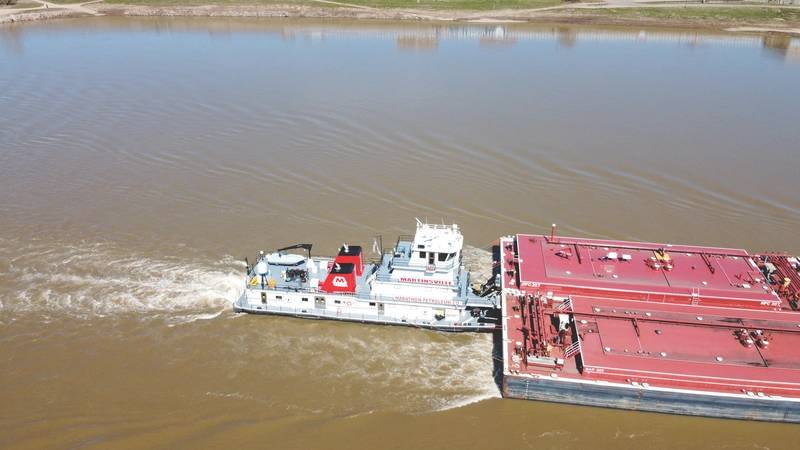 © Drew / Adobe Stock
© Drew / Adobe StockOverall, how would you rate the industry’s response to COVID-19 from a safety perspective?
While our industry, like all Americans, has been challenged by this global health crisis in profound ways, the domestic maritime supply chain has proven resilient in the face of COVID-19. The men and women of the tugboat, towboat and barge industry have played a key role in keeping our nation’s economy afloat, remaining open for business and continuing to move essential cargoes. Tugboat, towboat and barge companies have been able to maintain business continuity in large part because employers recognized early on that mariners are the lynchpin of their operations and protecting crewmember health and safety is key to keeping vessels moving and commerce flowing. The industry’s extensive experience with contingency planning, safety management systems and incident command structures has served it well in managing the health, safety and operational challenges posed by the pandemic. The result of these concerted and cooperative efforts has been to keep COVID-19 infections among the mariner workforce to a minimum – a win-win for health and safety and for the resilience of the maritime supply chain. To maintain this situation, it will be extremely important for employers, mariners and regulators to remain vigilant and not relax prematurely the prevention policies and social distancing procedures that have proven successful in keeping vessels largely virus-free.From your point of view, what are some of the top ways Subchapter M has affected industry safety?
Subchapter M has incentivized more towing companies than ever before to implement safety management systems. The experience of AWO members with the Responsible Carrier Program, which was accepted by the Coast Guard under 46 CFR §138.225(b) as an existing safety management system, has demonstrated that implementing a safety management system has produced quantifiable benefits in the form of fewer vessel incidents and personal injuries. That is why AWO continues to believe that the implementation of a safety management system is in and of itself the best way to promote continuous compliance. The purpose of a safety management system is to drive continuous improvement in safety performance, and its pillars—which are reflected in the TSMS requirements of Subchapter M—include procedures for verifying vessel compliance, assessing performance, identifying and correcting non-conformities, and applying lessons learned. We can already see from the data compiled by the Coast Guard that towing vessels using the TSMS option have far fewer deficiencies and detentions that towing vessels using the Coast Guard option. -
- Offshore Industry Leaders Invest Heavily In Safety Programs Maritime Reporter, Apr 2000 #36
The offshore oil industry market, by its very nature, is a challenging work environment that poses many safety hazards, particularly for individuals and companies which lack adequate safety training. Maritime Reporter & Engineering News sought the insight of two offshore industry leaders — Schlumberger
-
- Safety: A Shift in Culture Maritime Reporter, Oct 2013 #20
“A quality safety culture means doing things safely even when no one is looking” “Safety Culture” is one of those terms that is used a lot in the maritime industry. We all think it is important, and every operator wants a “good” safety culture. But how does one get it, and then keep it once it is there?
-
- Safety Management Systems: A Good fit for Passenger Vessels? Marine News, Jan 2019 #30
say ‘yes.’In its recently released SAFER SEAS DIGEST, Lessons Learned from Marine Accident Investigations (2017), the National Transportation Safety Board (NTSB) reports investigating numerous accidents across all modes of transportation where a properly implemented safety management system (SMS)
-
- Five Tips to Keep Workers Safe in 2024 Marine News, Feb 2024 #18
weather and long hours. If not properly managed, these hazards can result in serious injuries, illnesses and even fatalities. That is why ensuring the safety of waterfront workers is a top priority for all of us who work in the maritime industry. Not only does it protect the lives and wellbeing of workers
-
- Plan for Safety: Leadership is Key Marine News, Feb 2017 #20
Effective leadership and a safety management system are the keys to success. Failure to lead has consequences. Over the last 20 years we have seen a dramatic shift in the way that our industry operates. When I started practicing law, many companies looked at safety planning as a balancing act where you
-
- Safety: It's All About Culture Marine News, Sep 2014 #18
We in the passenger vessel industry strongly believe in safety. We want our operations to be safe to ensure the well-being of our crew and passengers and the protection of our assets. We work hard to establish appropriate safety policies and programs and we train and drill crew to ensure that we are all
-
- Sail Safe BC Ferries’ Safety Initiative Maritime Reporter, Jun 2013 #30
insurance claims costs by more than three-quarters. What are you waiting for? Can a vessel operator completely reshape its safety culture? Can it transform communications, training, operational practices and even employee engagement? And most importantly, if an operator is able
-
- Safety and Preparation on the Brownwater Radar Maritime Reporter, Jul 2016 #14
it is unclear whether the season, which began June 1, will bring about a few mild storms or a catastrophic Category 5 hurricane, one thing is for sure: safety and preparation are on the radars of the owners and operators of brownwater vessels. Although forecasters consider this year’s predicted 12 named
-
- Choose Wisely: A Deep Dive into Domestic Passenger Vessels SMS Proposed Rulemaking Marine News, May 2021 #18
On January 15, 2021, the U.S. Coast Guard issued an Advanced Notice of Proposed Rulemaking (ANPRM) for Safety Management System (SMS) requirements in the domestic passenger vessel industry (Docket No. USCG-2020-0123). This requirement will have the largest implications on the domestic passenger vessel
-
- Disasters at Sea & Their Impact on Shipping Regulation Maritime Reporter, Jun 2014 #40
Disasters Drive Key Safety Improvement Future safety policy to address the human element The history of marine safety is soaked in water and written in blood. “There is no other way around it,” says Robert Frump, author of “until the Sea Shall Set Them Free,” and Pulitzer Prize nominee, “Changes occur
-
- An Ever-vigilant Focus on Passenger Vessel Safety Marine News, Jan 2020 #18
When I came into office as the Passenger Vessel Association’s President for 2019 last January, I announced two strategic goals for our industry: to enhance safety and foster the professional growth of our next generation of leaders. I am proud to announce we have undertaken major initiatives and made progress
-
 )
March 2024 - Marine Technology Reporter page: 38
)
March 2024 - Marine Technology Reporter page: 38CBA and the batteries being tested, providing automatic sens- ies you have. Universal smart chargers are pre-programmed ing of the battery cell count, a safety check of the test rate, and for the correct charging pro? le for the different battery fami- recommendation of a minimum safe discharge voltage. lies
-
 )
March 2024 - Marine Technology Reporter page: 11
)
March 2024 - Marine Technology Reporter page: 11, including thousands of World War II-era unexploded mines and artillery shells. Post-con? ict mine clearance in the Black Sea will be critical to the safety and security of regional maritime opera- tions. But this will be neither quick nor easy given the volume of mine-like ob- jects scattered across
-
 )
April 2024 - Maritime Reporter and Engineering News page: 42
)
April 2024 - Maritime Reporter and Engineering News page: 42can ? nd that one overrides the other in an unique - role in the maritime industry going to happen, it must also become unexpected way, compromising safety. over recent years, as a ‘stakeholder’ si- more ef? cient very quickly to meet the “In SOLAS, every ship system is con- multaneously mindful of
-
 )
April 2024 - Maritime Reporter and Engineering News page: 41
)
April 2024 - Maritime Reporter and Engineering News page: 41that could ease the investigative work re- better decision-making comes improved use of digital shipping technology, com- quired for concluding claims. safety. Improved safety in turn helps to bined with a global shortage of experi- It can also help shipping companies increase crew welfare. enced of? cers
-
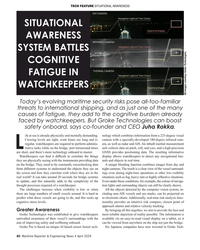 )
April 2024 - Maritime Reporter and Engineering News page: 40
)
April 2024 - Maritime Reporter and Engineering News page: 40, and as just one of the many causes of fatigue, they add to the cognitive burden already faced by watchkeepers. But Groke Technologies can boost safety onboard, says co-founder and CEO Juha Rokka. ife at sea is already physically and mentally demanding. nology which combines information from a 225-degree
-
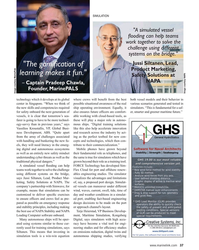 )
April 2024 - Maritime Reporter and Engineering News page: 37
)
April 2024 - Maritime Reporter and Engineering News page: 37solve the challenge using different systems on the bridge." – Jussi Siltanen, Lead, "The gami? cation of Product Marketing, learning makes it fun." Safety Solutions at NAPA – Captain Pradeep Chawla, Founder, MarinePALS Image courtesy MarinePals Image courtesy NAPA technology which it develops at its
-
 )
April 2024 - Maritime Reporter and Engineering News page: 35
)
April 2024 - Maritime Reporter and Engineering News page: 35in a variety of short weather and sea conditions, aiming to improve the advanced and entertaining ways. MarinePALS is therefore embracing a navigational safety skills required for CTV ship handling. new approach that involves interactive experiences and bite- Simulators are becoming as interconnected as onboard
-
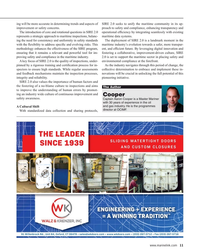 )
April 2024 - Maritime Reporter and Engineering News page: 11
)
April 2024 - Maritime Reporter and Engineering News page: 11ing will be more accurate in determining trends and aspects of SIRE 2.0 seeks to unify the maritime community in its ap- improvement or safety concerns. proach to safety and compliance, enhancing transparency and The introduction of core and rotational questions in SIRE 2.0 operational ef? ciency by
-
 )
April 2024 - Maritime Reporter and Engineering News page: 10
)
April 2024 - Maritime Reporter and Engineering News page: 10Maritime Safety © Roman/AdobeStock SIRE 2.0: Navigating the New Horizon of Maritime Safety By Captain Aaron Cooper, Programs Director, OCIMF he maritime industry is on the cusp of a signi? cant preparing vessel operators and vessel assurance teams for the transformation with the launch of the Ship
-
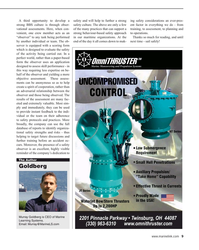 )
April 2024 - Maritime Reporter and Engineering News page: 9
)
April 2024 - Maritime Reporter and Engineering News page: 9A third opportunity to develop a safety and will help to further a strong ing safety considerations an ever-pres- strong BBS culture is through obser- safety culture. The above are only a few ent factor in everything we do - from vational assessments. Here, when con- of the many practices that can
-
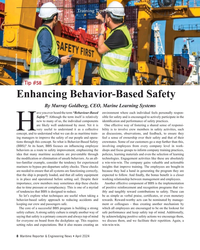 )
April 2024 - Maritime Reporter and Engineering News page: 8
)
April 2024 - Maritime Reporter and Engineering News page: 8Training Tips for Ships © By tuastockphoto/AdobeStock Tip #58 Enhancing Behavior-Based Safety By Murray Goldberg, CEO, Marine Learning Systems ave you ever heard the term “Behaviour-Based environment where each individual feels personally respon- Safety”? Although the term itself is relatively sible for
-
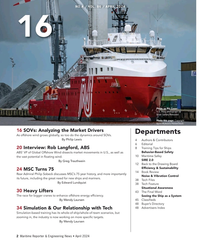 )
April 2024 - Maritime Reporter and Engineering News page: 2
)
April 2024 - Maritime Reporter and Engineering News page: 2the dynamics around SOVs. By Philip Lewis 4 Authors & Contributors 6 Editorial 8 Training Tips for Ships 20 Interview: Rob Langford, ABS Behavior-Based Safety ABS’ VP of Global Offshore Wind dissects market movements in U.S., as well as 10 Maritime Safey the vast potential in ? oating wind. SIRE 2.0 By
-
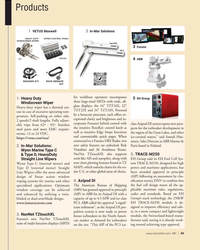 )
April 2024 - Marine News page: 43
)
April 2024 - Marine News page: 43. When ice-covered waters,” said Samuli Hän- https://vetus.com/usa/ connected to a Furuno DRS Radar, two ninen, Sales Director at ABB Marine & new safety features are unlocked: Risk Ports based in Finland. 2. In-Mar Solutions: Visualizer and AI Avoidance Route. Wynn Marine Type C NavNet TZtouchXL
-
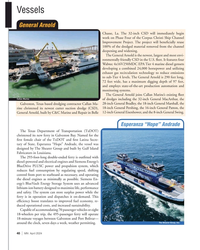 )
April 2024 - Marine News page: 40
)
April 2024 - Marine News page: 40minimally as possible. Siemens En- ergy’s BlueVault Energy Storage System uses an advanced lithium-ion battery designed to maximize life, performance and safety. The system can store surplus power while the ferry is in operation and dispatches it on-demand. This ef? ciency boost translates to improved fuel
-
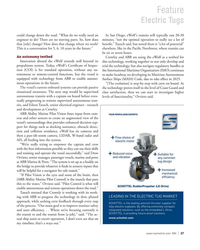 )
April 2024 - Marine News page: 37
)
April 2024 - Marine News page: 37to progress the technology in slow, phased approach, while seeking crew feedback through every step of the process. “Our main goal is to improve mariner safety and asset ef? ciency. . . Where we’re focusing currently is the transit to and the transit from [a job],” said. “The ac- tual ship assist or escort
-
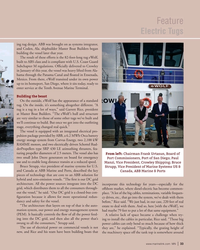 )
April 2024 - Marine News page: 33
)
April 2024 - Marine News page: 33, variable frequen- ? guration because it allows for more operational redun- cy drives, etc., that go into the system, we’ve dealt with them dancy and safety for the vessel. before,” Rice said. “We just had, in our case, 220 feet of real “The architecture that layers on top of that is the auto- estate to
-
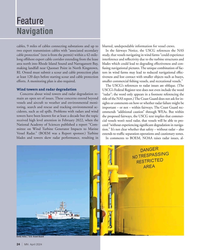 )
April 2024 - Marine News page: 24
)
April 2024 - Marine News page: 24“Com- ceed “without experiencing signi? cant degradation in naviga- mittee on Wind Turbine Generator Impacts to Marine tion.” It’s not clear whether that safety – without radar – also Vessel Radar.” (BOEM was a Report sponsor.) Turbine extends to traf? c separation operations and cautionary zones. blades
-
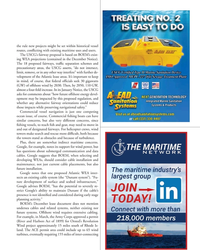 )
April 2024 - Marine News page: 23
)
April 2024 - Marine News page: 23may be impacted by this proposed regulation, and whether any alternative fairway orientations could reduce those impacts while preserving navigational safety.” Commercial vessel navigation is just one competing ocean issue, of course. Commercial ? shing boats can have similar concerns, but also very different
-
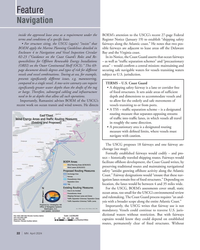 )
April 2024 - Marine News page: 22
)
April 2024 - Marine News page: 22the BOEM’s attention to the USCG’s recent 27-page Federal terms and conditions of a speci? c lease. Register Notice (January 19) to establish “shipping safety • For structure siting, the USCG (again) “insists” that fairways along the Atlantic coast.” He notes that two pos- BOEM apply the Marine Planning
-
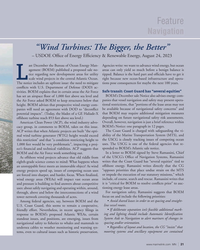 )
April 2024 - Marine News page: 21
)
April 2024 - Marine News page: 21set an airspace ? oor of 1,000 feet above sea level and the Air Force asked BOEM to keep structures below that panies that vessel navigation and safety may present opera- tional restrictions, that “portions of the lease areas may not height. BOEM advises that prospective wind energy com- panies will
-
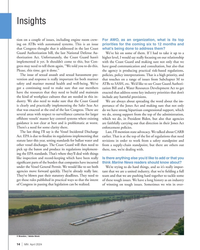 )
April 2024 - Marine News page: 14
)
April 2024 - Marine News page: 14. That is a high priority, and vention and response is really important for both mariner that touches on a range of issues from Subchapter M to safety and mariner mental health and well-being. We’ve ATBs to SASH, etc. We’d like to see Coast Guard Authori- got a continuing need to make sure that our
-
 )
April 2024 - Marine News page: 13
)
April 2024 - Marine News page: 13stage, whether a company are not new. These are vessels that have a really outstand- is using the TPO option, the TSMS option or the Coast ing and long safety record of operation in the US. I think Guard option, that that policy is being applied, that the it’s really important for the Coast Guard as they
-
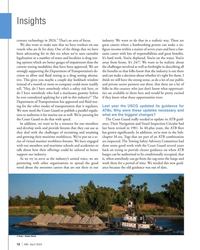 )
April 2024 - Marine News page: 12
)
April 2024 - Marine News page: 12of a month or more so company could more readily and private sector partners out there, that there are a lot of tell, “Hey, do I have somebody who’s a safety risk here, or folks in this country who just don’t know what opportuni- do I have somebody who had a marijuana gummy before ties are available to
-
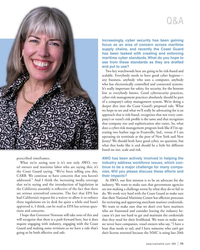 )
April 2024 - Marine News page: 11
)
April 2024 - Marine News page: 11good cyber hygiene— any business, anybody who uses a computer, anybody who has electronically controlled and connected systems. It’s really important for safety, for security, for the bottom line as everybody knows. Good cybersecurity practices, cyber-risk management practices absolutely should be part of
